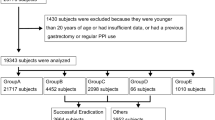To verify the hypothesis that chronic atrophic gastritis (CAG) is a precancerous lesion for gastric cancer, we investigated the correlation between the prevalence rates for CAG determined by levels of serum pepsinogens (I and II) of randomly selected, healthy, blood donors and the mortality rates for gastric cancer among four prefectures (Akita, Iwate, Miyagi, and Okinawa) in Japan. The prevalence rates for CAG according to a criterion that the level of pepsinogen I is below 70 ng/ml and the pepsinogen I to pepsinogen II ratio is below 3.0, were the highest in Akita for both sexes (38.8 percent in males, 37.8 percent in females) and the lowest in Okinawa (13.9 percent in males, 12.3 percent in females), where mortality rates for gastric cancer are the highest and the lowest in Japan, respectively. The correlation between the prevalence rates for CAG and the standardized mortality ratios for gastric cancer among these four prefectures was statistically significant in males (r=0.97, P=0.03), but less significant in females (r=0.92, P=0.08). These data strongly support the hypothesis that CAG is a precancerous lesion. The limitations of our cross-sectional study and the advantages of measuring the levels of serum pepsinogens in epidemiologic studies and in mass-screening programs for gastric cancer are discussed.
Similar content being viewed by others
References
Kawachi T, Kurisu M, Numanyu S, Sasajima K, Sano T, Sugimuma T. Precancerous changes in the stomach. Cancer Res 1976; 36: 2673–7.
Correa P. The gastric precancerous process. Cancer Surveys 1983; 2: 438–50.
Tatsuta M, Seagnsa T, Okuda S. Studies on gastritis in the upper portion of stomach by endoscopic Congo red test. Endoscopy 1973; 5: 61–9.
Samloff IM, Varis K, Ihamaki T, Siurala M, Rotter JI. Relationships among serum pepsinogen I, serum pepsinogen II, and gastric mucosal histology: A study in relatives of patients with pernicious anemia. Gastroenterol 1982; 83: 204–9.
Miki K, Ichinose M, Kawamura N, et al. The significance of low serum pepsinogen levels to detect stomach cancer associated with extensive chronic gastritis in Japanese subjects. Jpn J Cancer Res 1989; 80: 111–4.
Westerveld BD, Pols G, Lamers CB, et al. Clinical significance of pepsinogen A isozymogens, serum pepsinogen A and C levels, and serum gastrin levels. Cancer 1987; 59: 952–8.
Miki K, Ichinose M. Chronic atrophic gastritis and serum pepsinogen levels (in Japanese with English abstract). Jpn J Cancer Clin 1992; 38: 221–9.
Ichinose M, Miki K, Furihata C, et al. Radioimmunoassay of serum group I and group II pepsinogens in normal controls and patients with various disorders. Clin Chim Acta 1982; 126: 183–91.
Samloff IM. Cellular localization of group I pepsinogens in human gastric mucosa by immunofluorescence. Gastroenterol 1971; 61: 185–8.
Samloff IM, Lieblman WM. Cellular localization of the group II pepsinogens in human stomach and duodenum by immunofluorescence. Gastroenterol 1973; 65: 36–42.
Correa P. Chronic gastritis: A clinico-pathological classification. Am J Gastroenterol 1988; 83: 504–9.
Dixon XF. Campylobacter pylori and chronic gastritis. In: Rathbone BJ, Heatley RV, eds. CampylobacterPylori and Gastroduodenal Disease. Oxford, UK: Blackwell Scientific Publications, 1989; 106–16.
Laine L, Marin-Sorensen M, Weinstein WM. The histology of gastric erosions in patients taking nonsteroidal anti-inflammatory drugs (NSAIDs): a prospective study Gastroenterol 1988; 94: A247.
Yamaguchi N, Hayashi K, Chung S, et al. Comparison of the levels of serum pepsinogen I and II between Chinese and Japanese in rural area. J Kyoto Prej Univ Med 1987; 96: 1121–6.
Additional information
Drs Fukao and Hisamichi are with the Toboku University School of Medicine, Sendai, Japan. Dr Obsato is with the Akita Blood Center. Dr Fujino is with the Iwate Blood Center. Dr Endo is with the Miyagi Blood Center. Dr Iha is with the Okinawa Blood Center, Japan. Address correspondence to Dr Fukao, Department of Public Health, Toboku University School of Medicine, 2-1, Seiryomachi, Aobaku, Sendai, 980 Japan. This work was supported in part by a Grant-in-Aid for Cancer Research from The Ministry of Education, Science and Culture of Japan.
Rights and permissions
About this article
Cite this article
Fukao, A., Hisamichi, S., Ohsato, N. et al. Correlation between the prevalence of gastritis and gastric cancer in Japan. Cancer Causes Control 4, 17–20 (1993). https://doi.org/10.1007/BF00051709
Received:
Accepted:
Issue Date:
DOI: https://doi.org/10.1007/BF00051709




